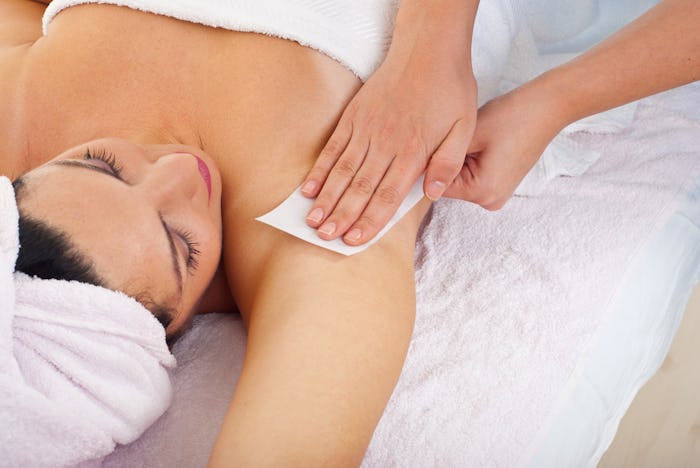Life

How To Keep Your Hair From Coming Back Post-Waxing
If you choose to get rid of your body hair, there are a lot of things to consider. First and foremost is the method you're going to use, whether that be waxing, shaving, laser hair removal treatments, or depilatory creams. Just within that seemingly simple decision, however, are many other considerations such as cost, and what best fits your lifestyle, and how long you can go in between treatments or sessions. If you’re attempting to compare all of your hair removal options, you may be wondering, does waxing keep hair away longer?
“Waxing removes hair at the root, which gives you that smoother, hair-free skin for longer," Summer Vasilis, co-founder of Waxing the City, tells Romper. Vasilis is quick to note, however, that laser hair removal will last slightly longer than waxing, but will require the same upkeep as a waxing routine because, contrary to formerly-popular belief, it’s not a permanent solution. Rather, it's a reduction in the amount of hair. Waxing, however, works with all types and colors of hair, while laser hair removal only works darker colored hairs, as board-certified plastic surgeon Dr. Johnstuart Guarnieri tells Romper in an email exchange. If you have blond, red, white, or gray hair, that might influence which method you ultimately choose to use.
If you choose to wax, there are some things you'll need to know. First of all, as Julia Davydov, co-founder of Wax Club, tells Romper by email, waxing lasts from four to six weeks, depending on how fast your hair normally grows. Vasilis adds that your hormones, genetic makeup, age, normal blood circulation, and consistency with waxing can also impact how quickly your hair grows and how often you'll need to have it removed. If you can stretch every wax to six weeks before feeling — or looking — a bit hairy, that's great, but others will likely need to make appointments closer together.
You'll also want to make sure you exfoliate regularly in order to keep your hair from coming back post-wax. Not doing so can result in ingrown hairs, which happen naturally when shaving. "If you’re not exfoliating on a regular basis, some of that dead skin can cover the pore and when you’re waxing, it’s a brand-new hair that’s coming through, so it has a really fine tip and sometimes it has a hard time breaking through that dead skin," Vasilis says. Loofahs, scrubs, and other products made for exfoliating can help keep your skin healthy and happy before and after waxes.
Although you might be tempted to shave in between waxing appointments in an effort to stretch your wax and not have to go as often, Davydov and Vasilis both caution against it. Shaving in between will, according to Vasilis, allow some of your hair growth to catch up to other follicles, which will prevent your wax from lasting as long.
Finally, if you're on any oral antibiotics, Guarnieri warns to make sure that you've been off them long enough before resuming waxing appointments. "Stay away from medication that makes your skin light-sensitive such as oral tetracycline ( and some other antibiotics) or topical vitamin A or Retin A creams. These things make the skin so sensitive that the wax can pull off the top layer of skin as well as the hair," he says. "We have people wait four months after the use of these agents in order to avoid skin damage." You don't want to cause any skin damage, so it's best to check with your doctor if you're unsure.
Although waxing may not be the method that keeps body hair away the longest, it's a popular option for those looking for an alternative to shaving or depilatory creams. Following your aesthetician or doctor's advice can help you make the most of it.